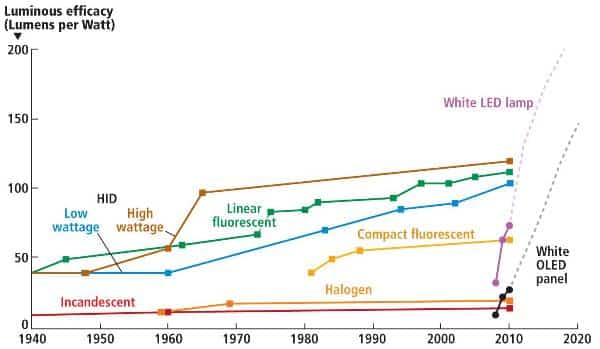One term that comes up a lot in regards to LED Lighting is Efficacy. If you are thinking of the word efficiently you are not alone and you are not far off. LED Efficacy is calculated by Lumens divided by Watts. This will tell you how well an LED Fixture or Lamp will produce visible light. This will also help you compare different LED products so you can compare apples to apples.
For example, there are several different LED tubes on the market. All of them claim to be the best. However, when you compare LED efficacy, it will help to identify what tube you should buy. Let’s do the math together. One tube is 15 watts delivering 2100 lumens, and another tube is 18 watts delivering 1800 lumens. For the first tube the is 140 lumens per watt. The second tube is 100 lumens per watt. This means that tube one is delivering more lumens per watt. A higher efficacy equals more energy savings over the long term of a project by using less energy to deliver more lumens.
When you buy a car, one of the factors you consider is miles per gallon. Depending on your needs, miles per gallon can range; a compact car compared to a work truck would range in miles per gallon tremendously. By comparing LED Efficacy you are can compare similar products.
When buying a LED product look for the Efficacy. A lower Efficacy can indicate older technology that will in the long run cost more in energy usage.
Let’s do another math problem together. You are looking to buy 100 High Bay lights. One High Bay is 100lm/w, the second High Bay is 150lm/w. High Bay 1 is $50 lower in cost than High Bay 2. Buying High Bay 1 would save you potentially $5,000 up front. For many this is the determining factor, but should it be? High Bay 2 saves you 50 Watts per fixture in energy savings to accomplish the same light output. How does this factor in energy savings? Say you have 100 fixtures in your facility. Savings 50 Watts per fixture x100 fixtures = 5,000 Watts or 5 Kilowatts. If your lights are on 8 hours a day 5 days a week that is 2,080 hours. That would be an additional 10,400 kilowatts per hour. At $0.10 per kilowatt hour that is additional $1,040 per year with High Bay 1. In 5 years High Bay 1 would cost $5,200 and in 10 years $10,400. Not to mention that High Bay1 was $50 lower in cost per fixture because it was older technology. A Higher Efficacy ends up being the more economical choice in the long run. Many LED fixtures come with a 5-10 year warranty so it is realistic to believe that you are making an investment in lighting that will have a minimum 10 year life expectancy. Efficacy must factor in before purchasing LED products.

